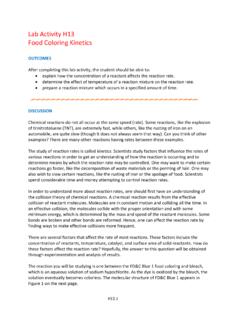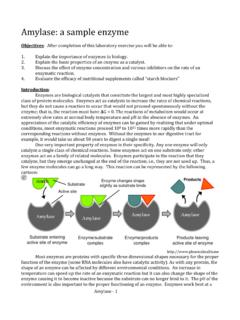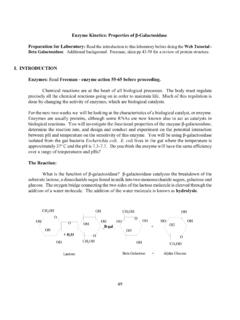Transcription of Effect of pH on Catalase Activity - The Pingry School
1 Effect of pH on Catalase Activity Tommie S. Hata The Pingry School Biology Mr. Hata Investigation date: September 23, 2002 Submitted: September 24, 2002 Comment [LU1]: Title and Name Comment [LU2]: Class, Period, Teacher s name, Date dueIntroduction Enzymes are biological catalysts that carry out thousands of chemical reactions that occur in living cells. They are large molecules that have a unique three-dimensional structure that allows it to react with a specific substrate. This investigation will explore the Effect of pH on this 3D structure. It is hypothesized that pH levels out of the normal range found in cells would denature the enzyme, slowing the enzyme s reaction rates .
2 Hydrogen peroxide (H2O2) is a poisonous chemical that is continually being formed as a byproduct of reactions in peroxisomes of living cells. Since it is poisonous, the cells must either get rid of it or change it to something nonpoisonous. If they cannot do this, they will die. The enzyme Catalase is found in animal and plant tissues, and is especially abundant in plant storage organs such as potato tubers, corns, and fleshy part of fruits. Catalase reacts with the H2O2 to form water and oxygen: 2H2O2 + Catalase = 2H2O + O2 + Catalase The amino acids forming the enzyme contain functional groups such as carboxyl groups and amino groups.
3 These functional groups are able to react with excess H+ ions in solution, resulting in the disruption of the enzymes structure. Most enzymes have an optimum in the neutral pH range that resembles that of the cell environment. In this experiment, Catalase will be extracted from fresh potato tubers. The extracted enzyme will be mixed with a solution of known pH. The reaction rate of the enzyme will then be measured and graphed. It is expected that the reaction rate will be highest for the enzymes mixed with pH 7. It is also expected for the reaction rates to drop as the pH is lowered or raised away from 7.
4 Methods and Materials A stock solution of Catalase enzyme solution was obtained 1. 40 mL of the enzyme solution was measured into eleven 50mL beakers that were labeled as follows: pH 2, pH 3, pH 4, pH 5, pH 6, pH 7, pH 8, pH 9, pH 10, pH 11, and pH 12. 10mL of a 1mol solution of each pH was added into each appropriate beaker. A second set of eleven 50mL beakers were obtained and labeled identically to the first set. 40 mL of 1% H2O2 solution was measured into these beakers. These will be used as the reaction beakers. Filter paper disks were punched out using a hole puncher. One at a time, a disk was immersed into the Catalase solution for 5 seconds.
5 The disk was then blotted on a paper towel for an additional 5 seconds. The disk was quickly immersed into the substrate solution (H2O2) and let go at the bottom of the beaker. The reaction time was measured as the time from when the disk was let go until when it floated flat on the surface of the solution. Comment [LU3]: Hypothesis, Comment [LU4]: PredictionComment [LU5]: Notice PAST TENSE, NOT written as set of instructions. Two trials were performed for each enzyme solution. The reaction times were recorded onto Table 1. Room temperature was recorded. Results Reaction times for the two trials were recorded and the average was used to calculate the rate as R=1/time.
6 This reaction time was then graphed. Table 1: Reaction times collected from the experiment along with calculations of average and reaction rate (R=1/t). Time are in seconds pH Trial 1 Trial 2 Total Average Rate 12 0 11 0 10 0 9 8 7 6 5 0 4 0 3 0 2 0 1 0 Note: reaction time was recorded as if the disk did not float after 6 minutes. Graph 1: Data from table 1. Effect of pH on Enzyme Reaction Rate Concentration (units/mL)Reaction Rate (1/sec) Comment [LU6]: Details of data collection and analysis.
7 Comment [LU7]: Did you remember to do this? Comment [LU8]: Once again, PAST TENSE. Comment [LU9]: Units clearly stated Comment [LU10]: Captions for each table and graph. Comment [LU11]: Graph must have title. Each axis should have a subtitle with units. Remember, independent variable on the x axis and the dependent variable on the y axis. Room Temperature: 23 As seen on the graph, reaction rates fell dramatically as pH deviated from 7. The enzyme displayed very little or no Activity at a pH higher than 9 or lower than 6. Discussion The purpose of this experiment was to investigate the effects of pH on Catalase Activity .
8 Since the enzyme is usually found in a fairly neutral environment, it was hypothesized that the enzyme Activity will be slowed or stopped in pH solutions that were either acidic or basic. It was expected that the reaction rate of the enzyme would be the highest in a solution of pH 7. It was also expected that the reaction rate would decrease as the pH deviated from 7. The data indicated that the enzyme reaction did slow down in pH solutions other than 7. It seems that the enzyme is somewhat more tolerant to slightly basic solutions compared to slightly acidic solutions. Enzyme Activity was observed through more basic solutions than was for acidic solutions.
9 The hypothesis was accepted. References 1 Hata, Tommie S. Enzymes: Quantitative Investigation of Catalase Activity , Lab handout. Comment [LU12]: General statements in reference to data. NOT A DISCUSSION. Comment [LU13]: Restate question, hypothesis, and prediction. PAST [LU14]: Accept or reject hypothesis. If rejected, include further discussion.










